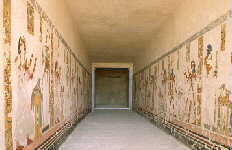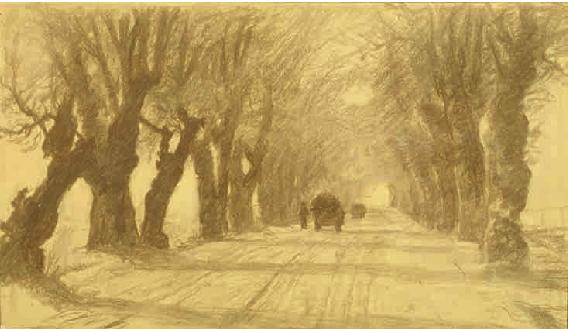Perspective Drawing Web Reading
Perspective Drawing Web Reading
Read the following and complete the ASULearn assignment.
You will use the concepts in lab as
I make my way around to answer any questions you have.
Recall that on the first day we examined Julian Beever's pavement drawings:
Butterfly
Globe wrong
view
Globe correct
view
Accident
Julian Beever: I decided to get into 3D after seeing the effect of tiles being removed
from the street, and later trying to recreate the sense of depth in a drawing.
Once I realised you could make things go down, I realised you could make
them appear to go up and I began experimenting.
[2006 Interview - Pavement Picasso by Sarah Loat]
We use perspective drawing, or the rules of projective geometry,
in order to accurately represent 3 dimensional space on a computer
screen or piece of paper.
Perspective drawing works because we can mathematically predict how our
eyes (and brains) will see.
The use of perspective began during the Renaissance. It changed the
way we represented and visualized the world.
We will now investigate some of the mathematical properties of
perspective drawing and see how they can
help us appreciate art and
the world around us.
Adapted by Dr. Sarah from Marc Frantz's Mathematics and Art.
The idea of projective geometry (also known as perspective drawing)
is to project a figure onto a plane.
For example, we might look at a building outside of a window, and
project what we see onto the window with masking tape.

Vanishing Points
Architectural lines that are parallel to one another
in real-life, but not parallel
to the plane of the window have images that converge to a common point
in the drawing called a vanishing point.
In projective geometry and in perspective drawing,
lines that were parallel in the real-world now intersect.
Hence, Playfair's postulate
(given a line and a point off the line there
exists a unique parallel to the line through the point)
does not hold in projective geometry since we cannot find any parallels.
There are zero parallels in this geometry (parallel is definied to
be lines or symmetric paths that never meet).
This is an especially effective use of perspective to show depth.

The correct use of vanishing points and other geometric
devices can greatly enhance not only one's ability to draw realistically,
but also one's ability to appreciate and enjoy art.
The picture below shows 2 vanishing points v1 and v2 obtained from the
perspective masking tape window drawing above.

Try to identify the vanishing point in the picture below.
After you have completed this, click on "Here is the answer!" to see the
vanishing point (the point in the painting that lines parallel in the
real world converge to).

Here is the answer!
Obtaining the Rules for Perspective Drawing
Experiments with perspective drawing were completed long ago,
when people with interdisciplinary interests (like math and art) were
perhaps more common. In this 1525 woodcut,
from "Unterweisung der Messung", by Albrecht Durer,
the screw eye on the wall is
the desired viewer's eye, the lute on the left is the object,
the taught string is a light ray, and the picture plane is mounted on
a swivel.

Leonardo Da Vinci and Brook Taylor
researched the question of how to find the viewing distance of a painting,
and Taylor's 1715 work was published in
Linear Perspective: Or, a New Method of Representing Justly All
Manner of Objects as They Appear to the Eye in All Situations London:
R. Knaplock.
These mathematicians and artists found the
precise mathematical rules for perspective drawing.
Understanding just a little bit about these rules can help us
understand art and computer animation.
A viewer's eye is located at the point E=(0,0,-d)
in the (x,y,z) coordinate
system located in 3-space (ie x=0, y=0, z=-d).
Notice that just one eye is used.
Out in the real world is an object,
represented by a vase here. As light rays from points on the object
(such as the point P(x,y,z) on the vase) travel in straight lines to the
viewer's eye, they pierce the picture plane (the x-y plane where z=0),
and we imagine them
leaving behind appropriately colored dots, such
as the point P'(x',y',0).
The collection of all projection points P'
comprise the perspective image (the
perspective drawing) of the object.

Perspective Theorem
Given a point (x,y,z) of a
real-life object with z > 0,
the projections of these real-life 3D vase coordinates onto the
2D sheet (the perspective drawing coordinates)
are given by the mathematical formulas.
x' = (d x) / (z+d)
y' = (d y) / (z+d)
where d is the distance from the viewer's eye at (0,0,-d)
to the picture plane (z=0).
Hence, given a real-life 3-D object,
the artist will draw x' and y' on their 2-D sheet.
Example
Suppose the viewer is 3 units from the picture
plane. If P(2,4,5) is a point on an object we wish to paint, find
the picture plane coordinates (x', y') of the perspective image of
P.
Solution
We have d=3, x=2, y=4, z=5. Thus
x'=(d x) / (z+d) = (3*2)/(5+3)=6/8=3/4 and
y'=(d y) / (z+d) =(3*4)/(5+3)=12/8=3/2.
As a second example, we might want to make a perspective drawing
of a real-life Christmas tree.
We first put a dot at the image (x',y') of
a point (x,y,z) where the coordinates of
x' and y' are given by the perspective theorem as above.
Then we continue to trace all possible such lines, accumulating
all possible points P' associated with our original object.
Once we have done this,
we will end up with a perspective drawing of our Christmas tree.

As we saw in the video,
college art history professor Sam Edgerton believes that
the discovery of the
rules of perspective ushered in the industrial revolution.
The newfound ability to reveal depth in drawings
led to unprecedented sharing of ideas.
One-Point Perspective and Viewing Distance
The following box has one vanishing point, but it also satisfies an
additional condition -- lines in the sketch which converge to
V represent lines in the real world which are perpendicular to the
picture plane. A painting which satisfies these two conditions is
said to be in one-point perspective.

When a picture is in true one-point perspective, there is an optimal
viewing distance d from which we should step back and view it from
the vanishing point V.
The rules of perspective assume that the viewer has one eye open
and is viewing the work of art from a distance d.
The idea is that the drawing follows mathematically precise rules,
and that if we close one eye and step back a distance d from V,
then we will appreciate the 3-D aspect better.
So, we want to locate the viewing distance d.
The way we do this is as follows:
We first locate the vanishing point V that parallel lines directly
in front of us converge to.
We then draw a horizontal line through V.
We find a rectangular feature that is on the same horizon (the same height)
as the horizontal line through V and has some lines converging to V.
We then trace one of the diagonals of this rectangular feature.
We look at the intersection of this diagonal
line with the horizontal line from
V, and call this intersection V'.
We measure the distance from V to V' which is equal to d.
In the drawing of the box below, in order to locate d,
we locate V' by drawing the dashed diagonal line of the top face of the box.
How do we know that V' is on the same horizontal line as V? Because the
dashed lines are images of real lines which are level with the
ground, so the sight lines of the viewer to their vanishing points must
be level also.

Calculating the Viewing Distance for
Interior of Antwerp Cathedral, by Peter Neeffs the Elder, 1651
In the figure below, we see
the trick applied to finding the viewpoint for the
Interior of Antwerp Cathedral painting by
by Peter Neeffs the Elder.
We first determine the vanishing point V directly in front of us,
which is easy to see, as
it is the intersection of lines which are supposed to be parallel
in the real-world. Some of the lines have been drawn in below
in order to highlight V.
Notice that lines that follow along the edges (coming from us towards
V) of the square tiles of
the floor also intersect at V.
Since the floor tiles are squares, they serve the same purpose as the square
top of the cube in the previous discussion.
Hence, our second point V' is calculated by following along a diagonal
(indicated on the picture) that follows along the vertices of the
square tiles.
If we had chosen the diagonals of other square tiles, we still would have
converged to V', or to a point V'' on the other side of V that is
also d units away from V.
In either case,
the viewing distance d
is the indicated length,
and the correct viewpoint is directly in front of the main
vanishing point V.
Although it is not possible to tell by viewing this small reproduction of
Interior of Antwerp Cathedral,
the effect of viewing the actual painting
in the Indianapolis Museum of Art gives a surprising sensation of
depth, of being "in" the cathedral.
The viewing distance is only about 24 inches, so most viewers never view
the painting from the best spot for the sensation of depth!

Recall that the reason that we want to determine d is that the picture
was drawn assuming that it would be viewed with one eye from a distance
d behind V, and so this is the optimal viewing place and distance.
If we view art from the wrong viewpoint, it can appear
distorted -- a cube can look like a dumpster.
If we view art from the correct viewpoint, it will give us the true
perspective desired by the artist.
In addition,
the majority of perspective works in museums are done in one-point
perspective, with clues that can help determine the viewing distance.
Thus our simple trick can actually be used in viewing and enjoying many
paintings in museums and galleries.
Of course you can't draw lines on the paintings and walls of an art
museum, so some other method is needed to find the main vanishing point and
the viewing distance. A good solution is to hold up a pair of wooden
shish kebab
skewers, aligning them with lines in the painting to find the location
of their intersection points. First, the main vanishing
point V is located. Then one skewer is held horizontally so that
it appears to go through V, and the other is held aligned
with one of the diagonals of the square tiles; the intersection
point of the skewers is then V'. The figures below show people
using their skewers to determine the viewpoint of a perspective painting.
Then, one by one, the viewers assume the correct viewpoint, looking with
one eye to enjoy the full perspective effect. If shish kebab skewers aren't
practical, any pair of straight edges, such as
credit cards, will work almost as
well for discovering viewpoints of perspective works.


Of course there are other important ways to view a painting.
It's good to get very close to examine brushwork, glazes, and fine details.
It's also good to get far away to see how the artist arranged colors, balanced
lights and darks, etc. Our viewpoint-finding techniques add
one more way to appreciate, understand, and enjoy many wonderful works of
art.
Adapted
from Marc Frantz's Mathematics and Art.










